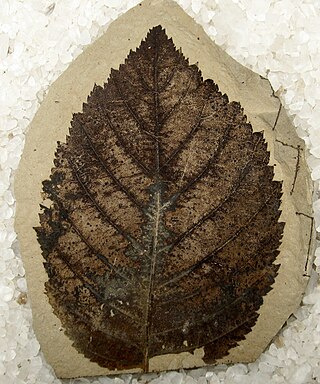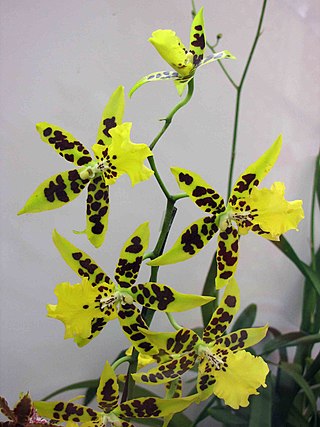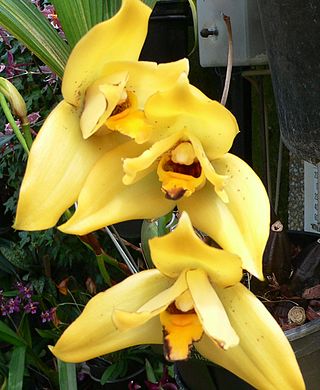Related Research Articles

In taxonomy, binomial nomenclature, also called binary nomenclature, is a formal system of naming species of living things by giving each a name composed of two parts, both of which use Latin grammatical forms, although they can be based on words from other languages. Such a name is called a binomial name, a binomen, binominal name, or a scientific name; more informally it is also historically called a Latin name. In the ICZN, the system is also called binominal nomenclature, "binomi'N'al" with an "N" before the "al", which is not a typographic error, meaning "two-name naming system".

A cultivar is a kind of cultivated plant that people have selected for desired traits and which retains those traits when propagated. Methods used to propagate cultivars include division, root and stem cuttings, offsets, grafting, tissue culture, or carefully controlled seed production. Most cultivars arise from purposeful human manipulation, but some originate from wild plants that have distinctive characteristics. Cultivar names are chosen according to rules of the International Code of Nomenclature for Cultivated Plants (ICNCP), and not all cultivated plants qualify as cultivars. Horticulturists generally believe the word cultivar was coined as a term meaning "cultivated variety".

In biology, a subgenus is a taxonomic rank directly below genus.

Paleobotany, also spelled as palaeobotany, is the branch of botany dealing with the recovery and identification of plant remains from geological contexts, and their use for the biological reconstruction of past environments (paleogeography), and the evolutionary history of plants, with a bearing upon the evolution of life in general. A synonym is paleophytology. It is a component of paleontology and paleobiology. The prefix palaeo- or paleo- means "ancient, old", and is derived from the Greek adjective παλαιός, palaios. Paleobotany includes the study of terrestrial plant fossils, as well as the study of prehistoric marine photoautotrophs, such as photosynthetic algae, seaweeds or kelp. A closely related field is palynology, which is the study of fossilized and extant spores and pollen.

Pyrus × bretschneideri, the ya pear or pearple or Chinese white pear, is an interspecific hybrid species of pear native to North China, where it is widely grown for its edible fruit.

A botanical name is a formal scientific name conforming to the International Code of Nomenclature for algae, fungi, and plants (ICN) and, if it concerns a plant cultigen, the additional cultivar or Group epithets must conform to the International Code of Nomenclature for Cultivated Plants (ICNCP). The code of nomenclature covers "all organisms traditionally treated as algae, fungi, or plants, whether fossil or non-fossil, including blue-green algae (Cyanobacteria), chytrids, oomycetes, slime moulds and photosynthetic protists with their taxonomically related non-photosynthetic groups ."
Botanical nomenclature is the formal, scientific naming of plants. It is related to, but distinct from taxonomy. Plant taxonomy is concerned with grouping and classifying plants; botanical nomenclature then provides names for the results of this process. The starting point for modern botanical nomenclature is Linnaeus' Species Plantarum of 1753. Botanical nomenclature is governed by the International Code of Nomenclature for algae, fungi, and plants (ICN), which replaces the International Code of Botanical Nomenclature (ICBN). Fossil plants are also covered by the code of nomenclature.
In botany, the correct name according to the International Code of Nomenclature for algae, fungi, and plants (ICN) is the one and only botanical name that is to be used for a particular taxon, when that taxon has a particular circumscription, position and rank. Determining whether a name is correct is a complex procedure. The name must be validly published, a process which is defined in no less than 16 Articles of the ICN. It must also be "legitimate", which imposes some further requirements. If there are two or more legitimate names for the same taxon, then the correct name is the one which has priority, i.e. it was published earliest, although names may be conserved if they have been very widely used. Validly published names other than the correct name are called synonyms. Since taxonomists may disagree as to the circumscription, position or rank of a taxon, there can be more than one correct name for a particular plant. These may also be called synonyms.
The International Code of Nomenclature for Cultivated Plants (ICNCP) is a guide to the rules and regulations for naming cultigens, plants whose origin or selection is primarily due to intentional human activity. It is also known as Cultivated Plant Code. Cultigens under the purview of the ICNCP include cultivars, Groups, and grexes. All organisms traditionally considered to be plants are included. Taxa that receive a name under the ICNCP will also be included within taxa named under the International Code of Nomenclature for algae, fungi, and plants, for example, a cultivar is a member of a species.

The shipova, scientific name × Pyraria irregularis, synonyms including × Sorbopyrus irregularis, is a hybrid of the European pear and the common whitebeam. It is a small to medium-sized tree growing to 10–18 m tall, with deciduous oval leaves 7–11 cm long and 5–6 cm broad. The fruit is a pome 2.5–3 cm long; it is edible with a sweet, yellowish flesh, which tastes similar to a Nashi pear.

× Miltonidium, abbreviated as Mtdm. in the horticultural trade, is the nothogenus for hybrids between the orchid genera Miltonia and Oncidium. An example is Miltonidium Purple Sunset, which is a hybrid of Miltonia Victoria and Oncidium hastilabium.

In horticulture, a graft-chimaera may arise in grafting at the point of contact between rootstock and scion and will have properties intermediate between those of its "parents". A graft-chimaera is not a true hybrid but a mixture of cells, each with the genotype of one of its "parents": it is a chimaera. Hence, the once widely used term "graft-hybrid" is not descriptive; it is now frowned upon.
A cultigen or cultivated plant is a plant that has been deliberately altered or selected by humans. Cultigens result from artificial selection. These plants have commercial value in horticulture, agriculture or forestry. Because cultigens are defined by their mode of origin and not by where they grow, plants meeting this definition remain cultigens whether they are naturalised, deliberately planted in the wild, or grown in cultivation.

In biology, taxonomic rank is the relative level of a group of organisms in an ancestral or hereditary hierarchy. A common system of biological classification (taxonomy) consists of species, genus, family, order, class, phylum, kingdom, and domain. While older approaches to taxonomic classification were phenomenological, forming groups on the basis of similarities in appearance, organic structure and behaviour, methods based on genetic analysis have opened the road to cladistics.

× Brassidium, abbreviated in trade journals Brsdm, is an artificial intergeneric hybrid between the orchid genera Brassia and Oncidium. When Cochlioda and Odontoglossum are sunk into Oncidium, × Maclellanara (Mclna.), × Odontobrassia (Odbrs.) and × Sanderara (Sand.) are synonyms.

Cultivated plant taxonomy is the study of the theory and practice of the science that identifies, describes, classifies, and names cultigens—those plants whose origin or selection is primarily due to intentional human activity. Cultivated plant taxonomists do, however, work with all kinds of plants in cultivation.

The term grex, derived from the Latin noun grex, gregis, meaning 'flock', has been expanded in botanical nomenclature to describe hybrids of orchids, based solely on their parentage. Grex names are one of the three categories of plant names governed by the International Code of Nomenclature for Cultivated Plants; within a grex the cultivar group category can be used to refer to plants by their shared characteristics, and individual orchid plants can be selected and named as cultivars.

Magnolia × wieseneri is a hybrid plant in the genus Magnolia and family Magnoliaceae. A small tree or large shrub with white highly fragrant blooms, it is the progeny of Magnolia sieboldii and Magnolia obovata.

× Phylliopsis is a nothogenus of flowering plants in the heath and heather family Ericaceae. Artificially created hybrids, they are the result of crosses between species of two distinct heath genera, Kalmiopsis and Phyllodoce. This type of intergeneric hybridization is quite rare, and is indicated by a multiplication symbol before the name. The name Phylliopsis is an example of a portmanteau word, a combination of the two parents' names. The cultivar × Phylliopsis 'Coppelia' has gained the Royal Horticultural Society's Award of Garden Merit. The RHS lists the nominal species name as Phylliopsis hillieri.
× Aegilotriticum is a nothogenus of flowering plants in the family Poaceae. They are the result of crosses between species of two distinct grass genera, Aegilops (goatgrasses) and Triticum (wheat). This type of intergeneric hybridization is quite rare, and is indicated by a multiplication symbol before the name. The name Aegilotriticum is an example of a portmanteau word, a combination of the two parents' names. This genus has at least 7 species.
References
- McNeill, J.; et al. (Barrie, F.R.; Buck, W.R.; Demoulin, V.; Greuter, W.; Hawksworth, D.L.; Herendeen, P.S.; Knapp, S.; Marhold, K.; Prado, J.; Prud'homme Van Reine, W.F.; Smith, G.F.; Wiersema, J.H.; Turland, N.J.) (2012). International Code of Nomenclature for algae, fungi, and plants (Melbourne Code) adopted by the Eighteenth International Botanical Congress Melbourne, Australia, July 2011. Vol. Regnum Vegetabile 154. A.R.G. Gantner Verlag KG. ISBN 978-3-87429-425-6.